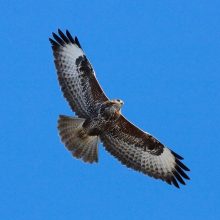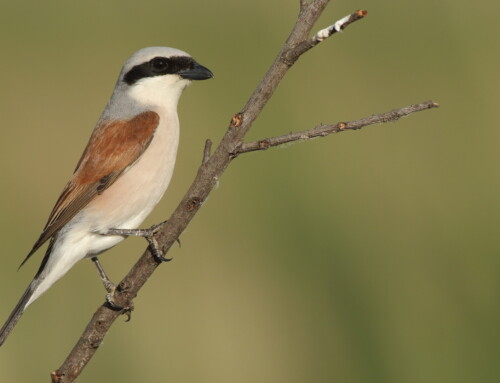What’s on the menu for buzzards this winter?
LINKED PAPER
Winter diet of Common Buzzards Buteo buteo on a Scottish grouse moor. Francksen, R.M., Whittingham, M.J., Ludwig, S.C. & Baines, D. 2016. Bird Study. DOI: 10.1080/00063657.2016.1238868 VIEW
One of the most remarkable changes in British wildlife over the last 40 years has been the population recovery and range expansion of the Common Buzzard Buteo buteo. Growing up in East Anglia, I can remember the sight of a buzzard being a rare and special thing. Following decades of persecution and indirect organo-chlorine poisoning (Newton 1979; Dare 2015), buzzards became restricted to the western most areas of Britain. Fast-forward to today and they are near- ubiquitous part of Britain’s wildlife. In fact, the most recent BTO Atlas (Balmer et al. 2014) estimates that buzzards have increased their breeding range by 81% over the last 40 years, while their winter range has expanded by 74% in the last 30 years. Buzzards are now the most abundant diurnal raptor in Britain, with a recent population estimate of 56,000 – 77,000 breeding pairs (Musgrove et al. 2013).
To many, the recovery of buzzards epitomises a conservation success story. However, amongst some managers of game birds, the increased number of buzzards has raised concern. Recently, this has predominately centred around the impact of buzzard predation on released pheasants. However, the potential for buzzards to impact on Red Grouse Lagopus lagopus scotica is also of concern to some grouse managers, yet until recently remained largely unstudied.

Understanding the role that buzzards play in these predator-prey interactions begins with accurate assessment of their diet. To date, the vast majority of raptor diet studies have been conducted during the breeding season owing to the concentration of activity at a nest (Lewis et al. 2004), yet raptor diet can vary seasonally (Mañosa & Cordero 1992; Amar et al. 2003). We therefore set out to assess the winter diet of buzzards, focussing on Langholm Moor in southern Scotland which is currently the location of the Langholm Moor Demonstration Project (LMDP), and prior to that was the main study site of the Joint Raptor Study. The LMDP aims to restore Langholm Moor to a driven red grouse moor alongside protection of raptors, and monitor the responses of grouse, raptors and habitat to the reinstatement of moorland management. The diet and winter behaviour of buzzards, the most numerous raptor on the moor, were therefore of great interest.
As part of the management for red grouse, gamekeepers on Langholm Moor operate ‘crow cage traps’ for the control of Carrion Crows Corvus corone. These traps are baited with carrion, which also attracted buzzards as non-target species. The catching of buzzards in these traps offered us an opportunity to better understand the winter behaviour of these individuals. Therefore, in the autumn and winter of 2013, we fitted nine buzzards with either a satellite (GPS) tag, or a radio-tag. Our original aim was to map the winter home ranges of these individuals, and perhaps follow their movements at a fine scale to better understand their winter hunting habits. Unfortunately for the solar powered satellite tags, the sun made even less of an appearance over Langholm Moor that winter than usual! This meant that the tags often had insufficient power to allow us to follow movement in fine detail. They did however allow us to locate the roosting sites of these buzzards. They also revealed that buzzards were remarkably regular in their roosting habits, usually choosing to roost in the same tree or small area of woodland each night. Once we had identified the location of these roost sites, we were able to visit them and collect a large number of pellets (parcels of regurgitated undigested food). By learning about the regularity and habitats of roosting buzzards, we were then able to increase our sample of roosting buzzards by conducting vantage point watches over apparently suitable areas of roosting habitat. In this way, we identified 44 buzzard roost sites over two winters (2013/14 and 2014/15), and from these roosts we collected a total of 764 individual pellets, which we analysed to identify their contents.

Our results showed that buzzards were overwhelmingly reliant on small mammal prey during the winter. Small mammals (principally Field Voles Microtus agrestis) comprised 60-67% of all identified prey items and occurred in 88-92% of pellets, with variation between each winter. Red grouse remains comprised 1.1% and 0.6% of prey items, and occurred in 3% and 2% of pellets from each winter respectively.
Our analyses also showed that buzzard diet composition varied between winters. Monitoring on Langholm Moor suggested although vole populations were stable, red grouse numbers significantly declined during this study period. Buzzards ate fewer red grouse when grouse numbers were lower, but appeared to eat more lagomorphs, small passerines, corvids and pigeons. In essence, our study yielded three key results:
- Buzzards relied on small mammal prey during the winter.
- When available, red grouse formed a minor dietary component.
- Buzzards are opportunistic hunters, and as such their diet can change over time as prey availabilities also change.
It is important to note that, whilst interesting in itself, assessment of diet alone can’t tell us the whole story about the potential for a predator to impact on their prey. For instance, the occurrence of a prey item in a buzzard pellet does not reveal whether the buzzard killed the prey or scavenged it once already dead. Furthermore, pellet analysis alone has its own set of limitations (Francksen et al. 2016), including the potential that some prey are under- or over-estimated relative to others. By way of example, it is known that buzzards in many places make use of earthworms during the autumn and winter (Dare 2015), however we found very little evidence of earthworms in our analysis of pellets. Does this suggest that buzzards on Langholm Moor have limited access to this resource given the acidic, earthworm poor soils? Or does it suggest that, if eaten, their remains are completely digested and are largely undetectable in our analyses? Exploration of caveats such as these will be important for the continuing exploration of buzzard diet and impact on prey.

Assessing the impact of a predator on a given prey resource depends on a number of factors. These include, but are not limited to, assessing the rate of scavenging relative to predation; assessing whether predation is additive to other forms of mortality; and defining what level of impact is acceptable to the management aims. Our study has only begun to scratch the surface of these issues. Nevertheless, it is my hope that any decisions which affect the systems in which buzzards and their prey operate are based on sound ecological evidence.
References and further reading
Amar, A., Redpath, S.M. & Thirgood, S.J. 2003. Evidence for food limitation in the declining hen harrier population on the Orkney Islands, Scotland. Biological Conservation, 111, 377–384. VIEW
Balmer, D., Gillings, S., Caffrey, B. & Swann, B. 2014. Bird Atlas 2007-11: The Breeding and Wintering Birds of Britain and Ireland. British Trust for Ornithology, Thetford.
Dare, P. 2015. The Life of Buzzards. Whittles Publishing, Dunbeath.
Francksen, R.M., Whittingham, M.J. & Baines, D. 2016. Assessing prey provisioned to Common Buzzard Buteo buteo chicks: a comparison of methods. Bird Study, 63, 303–310.
Lewis, S.B., Fuller, M.R. & Titus, K. 2004. A comparison of three methods for assessing raptor diet during the breeding season. Wildlife Society Bulletin, 32, 373–385. VIEW
Ludwig, S.C., Roos, S., Bubb, D. & Baines, D. 2016. Long-term trends in abundance and breeding success of red grouse and hen harriers in relation to changing management of a Scottish grouse moor. Wildlife Biology, DOI: 10.2981/wlb.00246. VIEW
Mañosa, S. & Cordero, P. 1992. Seasonal and sexual variation in the diet of the common buzzard in northeastern Spain. Journal of Raptor Research, 26, 235 – 238.
Musgrove, A., Aebischer, N.J., Eaton, M., Hearn, R., Newson, S.E., Noble, D.G., Parsons, M., Risely, K. & Stroud, D. 2013. Population estimates of birds in Great Britain and the United Kingdom. British Birds, 106, 64–100. VIEW
Newton, I. 1979. Population Ecology of Raptors. T. & A.D. Poyser, Berkhamstead.
Image credit
Featured image: Common Buzzard, Buteo buteo © raz1940 et Charlotte
If you want to write about your research in #theBOUblog, then please see here.





